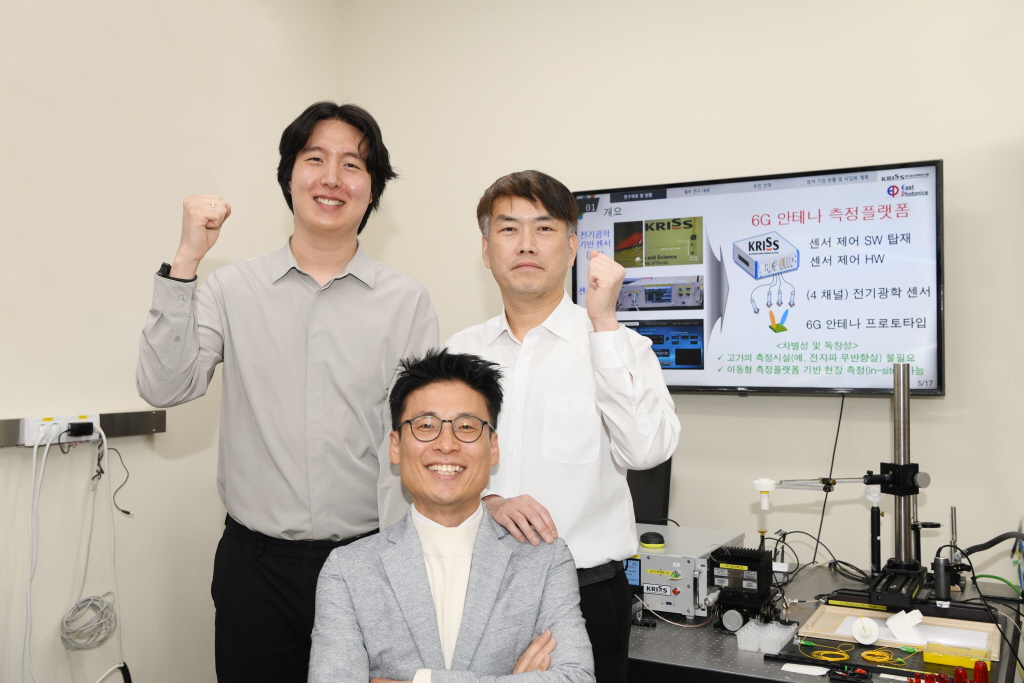한국표준과학연구원(KRISS, 원장 이호성)이 6G 안테나 측정 장비를 국산화하며, 6G 상용화에 속도가 붙을 것으로 기대된다.

▲KRISS 전자파측정그룹 (앞줄부터 시계방향)홍영표 책임연구원, 황인준 선임연구원, 이동준 책임연구원
활용성 높은 이동형·왜곡 없는 비금속 센서
이스트포토닉스, 3억원 규모 기술이전 완료
한국표준과학연구원(KRISS, 원장 이호성)이 6G 안테나 측정 장비를 국산화하며, 6G 상용화에 속도가 붙을 것으로 기대된다.
표준연은 최근 6G 통신 안테나의 성능 측정 장비를 국산화하는 데 성공했다고 밝혔다.
대체로 주파수 대역이 올라갈수록 통신 속도는 빨라지지만 통신 가능 거리가 짧아진다. 6G 통신(7∼24 GHz 예정)은 현재의 5G 통신(3.5 GHz)에 비해 주파수 대역이 높아지므로 짧아지는 통신 가능 거리 문제를 해결하기 위한 안테나 관련 기술들이 필요하다.
이처럼 많은 기술이 접목된 6G 안테나가 제대로 동작하기 위해서는 성능 측정이 선행돼야 한다. 정밀한 성능 측정을 통해 시제품 단계에서 안테나의 오작동 원인을 개선하고 품질을 높이는 것은 물론 양산 시점도 단축할 수 있기 때문이다.
KRISS 전자파측정그룹 연구팀은 광학적인 방식을 적용한 비금속 센서 기반 6G 안테나 측정 장비를 개발했다.
안테나의 성능을 평가하기 위해서는 센서와 일정 거리를 두고 안테나에서 발생하는 전자파를 측정한다. 기존에는 금속 센서를 이용하다 보니 금속 고유의 전자파 반사 특성인 커플링 현상이 발생해 측정값에 왜곡이 발생했으나 좁쌀 크기의 비금속 기반 센서로 대체해 이 문제를 간단히 해결했다.
안테나 측정 시 센서와의 거리도 기존 수 m에서 수 mm로 줄여 측정 시간도 1/10 이상 줄게 되었다. 더욱이 기존의 측정은 전자파 무향실과 같은 매우 크고 고정된 전용 측정시설에서만 가능했으나 KRISS가 개발한 측정 장비는 크기와 중량이 컴퓨터 본체와 유사할 정도로 경량화되어 이동이 쉽고 일반 실험실에서 측정 가능하다는 강점이 있다.
KRISS는 광섬유 통신 및 중계기 분야 기업인 ㈜이스트포토닉스에 기술료 3억원 규모로 해당 기술을 이전했고 4월8일 한국표준과학연구원 행정동에서 협약식을 체결했다.
KRISS 홍영표 책임연구원은 “현재 국내 6G 관련 연구가 소재·부품 분야에만 집중되어 있고 측정 장비 연구개발은 전무한 상황”이라며 “이전 28 GHz 5G 통신의 아쉬운 경험을 거울삼아 6G 인프라 구축이 우선되어야 하고 측정 장비 개발은 그 한 축을 담당할 것”이라고 말했다.
㈜이스트포토닉스 석호준 대표는 “지금까지는 스마트폰·기지국 안테나 측정 장비가 모두 고가의 외산이었지만, KRISS와 긴밀히 협력해 6G 안테나 측정 장비 국산화에 앞장서겠다”며 “기존 측정 장비와 달리 경량화돼 이동 측정이 가능하다는 점을 강점으로 착실히 사업화 계획을 세워나가겠다”고 포부를 밝혔다.
